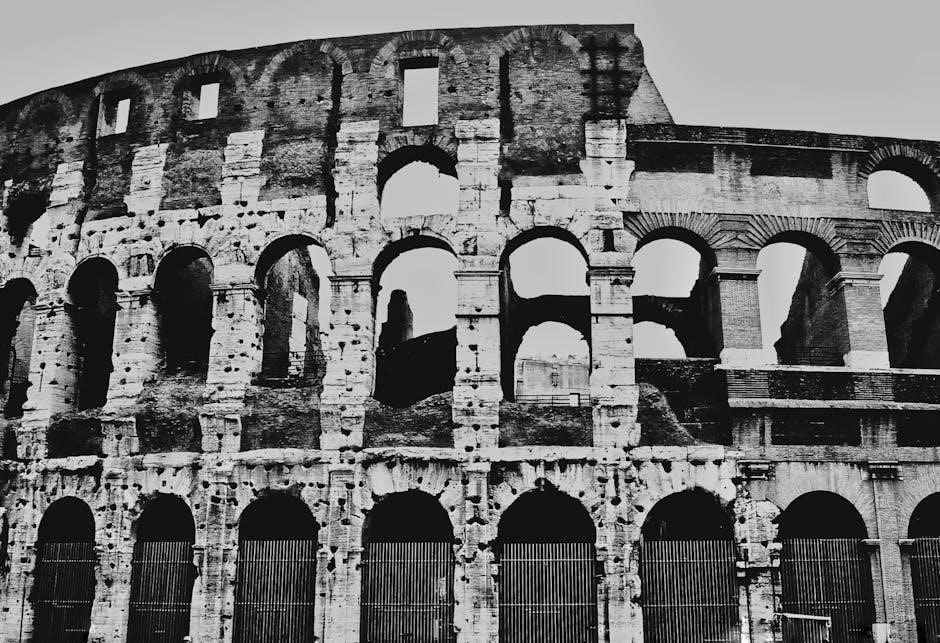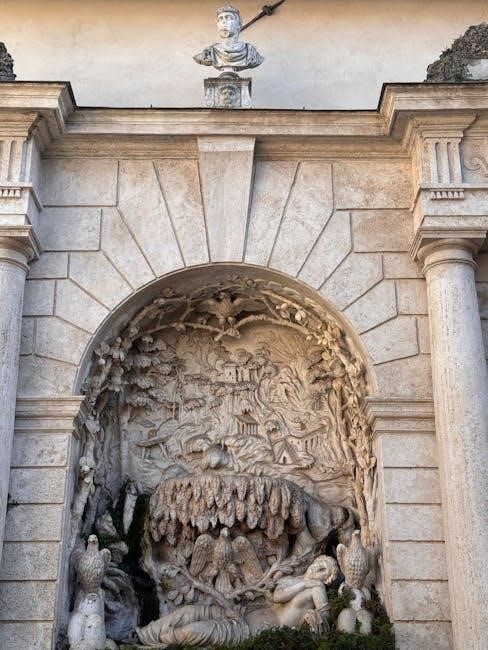The fall of the Roman Empire, explored in Edward Gibbon’s seminal work, marks a pivotal transition from grandeur to collapse, driven by military, economic, and political turmoil.
1.1 Historical Context and Significance
The fall of the Roman Empire is a pivotal moment in world history, marking the transition from the ancient world to the medieval period. The Western Empire’s collapse in 476 CE symbolized the end of Roman dominance, while the Eastern Empire survived for another millennium. This event underscores the complexities of power, governance, and societal transformation, as explored in Edward Gibbon’s seminal work.
1.2 Overview of the Decline and Fall
The Roman Empire’s decline was a gradual process marked by military overextension, economic strain, and political instability. External pressures from barbarian invasions and internal corruption weakened its structure. The Western Empire fell in 476 CE, while the Eastern Empire, later known as the Byzantine Empire, survived for another millennium. This period signifies a complex transition from ancient to medieval societies.

Military Factors in the Decline
Overextension and military exhaustion significantly contributed to the decline, as constant warfare drained resources and left the empire vulnerable to barbarian invasions and internal instability.
2.1 Overextension of the Empire and Military Exhaustion
The Roman Empire’s vast territorial expansion led to significant military overextension, straining resources and manpower. Constant warfare and the need to defend extensive borders drained the empire’s strength, while reliance on mercenaries further weakened its military foundation. This exhaustion left the empire vulnerable to external threats and internal instability, accelerating its decline.
2.2 External Pressures and Barbarian Invasions
Barbarian invasions intensified the empire’s decline, as relentless attacks by groups like the Visigoths and Vandals overwhelmed Roman defenses. The sacking of Rome in 455 CE exemplified the empire’s vulnerability. External pressures exacerbated internal weaknesses, leading to territorial fragmentation and the eventual collapse of the Western Empire in 476 CE, marking a significant chapter in Rome’s fall.
Economic Decline and Its Impact
Economic decline severely impacted the Roman Empire, with excessive taxation and rising inequality straining the populace, contributing to widespread instability and weakening its societal foundations.
3.1 Inflation, Devaluation of Currency, and Trade Issues
Economic turmoil plagued the Roman Empire, with rampant inflation and currency devaluation eroding purchasing power. The debasement of coinage, particularly the reduction of silver content, led to hyperinflation, disrupting trade and destabilizing the economy. Trade issues, including disrupted routes and declining merchant activity, further exacerbated economic instability, straining resources and contributing to widespread societal strain and decline in living standards across the empire.
3.2 Taxation Burdens and Economic Inequality
Heavy taxation became a significant burden, disproportionately affecting landowners and the middle class, while the elite often evaded payments. This led to widespread economic inequality, with the wealthy amassing more power and the poor facing destitution. The tax system, designed to fund military campaigns and bureaucracy, further strained the economy, exacerbating social unrest and contributing to the empire’s decline in stability and cohesion over time.

Political Instability and Corruption
Constantine’s division of the empire and subsequent corruption led to weak leadership, mismanagement, and power struggles, destabilizing the empire and accelerating its decline.
4.1 Civil Wars, Power Struggles, and Weak Leadership
The Roman Empire’s decline was hastened by frequent civil wars and power struggles, as ambitious generals and politicians vied for control. Constantine’s division of the empire into Eastern and Western halves created instability, with the Western Empire facing greater turmoil. Weak leadership, short-lived emperors, and internal conflicts further eroded political cohesion, leaving the empire vulnerable to external threats and unable to maintain effective governance.
4.2 Bureaucratic Corruption and Mismanagement
Bureaucratic corruption and mismanagement significantly weakened the Roman Empire. Officials often embezzled funds, and a bloated administrative system led to inefficiency. Nepotism and cronyism flourished, with positions granted based on connections rather than merit. This corruption drained resources, eroded public trust, and hindered effective governance, exacerbating the empire’s decline and creating an environment ripe for collapse.

Social and Cultural Factors
The decline of Roman values and social cohesion contributed to the empire’s fall. Increased slavery and labor shortages disrupted the economy, further destabilizing society and culture.
5.1 Decline of Roman Values and Social Cohesion
The decline of Roman values and social cohesion significantly contributed to the empire’s fall. Moral decay, corruption, and a shift from collective responsibility to self-interest eroded societal bonds; External pressures and internal conflicts further fragmented unity, while public entertainment like gladiatorial games distracted from underlying issues. The rise of Christianity also introduced divisions, weakening traditional Roman identity and social structures, exacerbating overall instability and decline.
5.2 Impact of Slavery and Labor Shortages
The widespread use of slavery in the Roman Empire stifled technological innovation and led to labor shortages, particularly in agriculture. As the empire expanded, the reliance on slave labor increased, reducing the need for free labor and creating economic disparities. This system, combined with declining birth rates and plagues, further strained the workforce, undermining the empire’s economic stability and contributing to its decline.
Key Historical Figures and Events
The fall of the Western Roman Empire in 476 CE marked a pivotal moment, while figures like Constantine and Theodosius shaped its trajectory through significant reforms and divisions.
6.1 Role of Constantine and the Division of the Empire
Constantine’s reign marked a pivotal era, as he established Constantinople as the new capital and embraced Christianity, ending persecution. His division of the empire into Western and Eastern halves laid the groundwork for distinct trajectories. The Western Empire’s eventual decline contrasted with the Eastern, or Byzantine, Empire’s resilience. Constantine’s reforms and legacy profoundly shaped the empire’s final centuries, influencing its political and religious landscape.
6.2 The Fall of the Western Empire (476 CE)
The Western Roman Empire officially ended in 476 CE when Odoacer, a Germanic king, deposed Emperor Romulus Augustulus. This event marked the culmination of internal decay, military overextension, and external pressures. The Eastern, or Byzantine, Empire survived, but the Western Empire’s collapse symbolized the end of Roman dominance in Europe, leaving a legacy of fragmentation and transformation in its wake.
The Eastern Roman Empire (Byzantine Empire)
The Eastern Roman Empire, known as the Byzantine Empire, survived for over a millennium after the Western Empire’s fall, preserving Roman traditions and evolving into a distinct cultural entity.
7.1 Survival and Transformation of the Eastern Empire
The Eastern Roman Empire, or Byzantine Empire, survived the Western Empire’s collapse by adapting to challenges. Constantine’s establishment of Constantinople as the capital marked a turning point, blending Roman traditions with Greek and Christian influences. This transformation allowed the Eastern Empire to endure for over a thousand years, maintaining its identity despite political and military pressures, until its eventual fall in 1453.
7.2 Legacy of the Byzantine Empire
The Byzantine Empire left a profound legacy, preserving Roman law, fostering Eastern Orthodox Christianity, and influencing art and architecture. Its legal codes, such as Justinian’s Corpus Juris Civilis, shaped modern legal systems. Cultural achievements, including Byzantine mosaics and Hagia Sophia, remain iconic. The empire also acted as a bridge between ancient and modern worlds, preserving classical knowledge during the Middle Ages.
Modern Interpretations and Debates
Modern historians debate the Roman Empire’s decline, emphasizing economic decay, military overextension, and political corruption. These discussions highlight the complexity of its collapse and enduring relevance.

8.1 Historiographical Perspectives on the Fall
Historians have long debated the Roman Empire’s decline, with Gibbon’s work laying the groundwork. Modern scholars challenge his views, emphasizing economic decay, military overextension, and political instability. The fall is now seen as a complex, gradual process rather than a single event, with the Eastern Empire’s survival highlighting the West’s unique vulnerabilities and the legacy of its transformation.
8.2 Contemporary Theories and Controversies
Contemporary theories on the Roman Empire’s fall emphasize a nuanced understanding, moving beyond Gibbon’s narrative. Scholars debate whether the decline was a gradual process or triggered by specific events. Recent research highlights factors like environmental degradation, pandemics, and societal restructuring. The role of external barbarian invasions versus internal decay remains contentious, reflecting ongoing scholarly disputes about the empire’s collapse and legacy.

The Legacy of the Roman Empire
The Roman Empire’s legacy endures through its cultural, legal, and architectural contributions, shaping modern societies and inspiring historical inquiry into its rise, decline, and enduring impact.
9.1 Cultural, Legal, and Architectural Contributions
The Roman Empire’s cultural legacy is profound, shaping modern languages, legal systems, and architecture. Latin’s influence persists in many tongues, while Roman law underpins Western jurisprudence. Architectural innovations like the dome and aqueducts remain iconic, reflecting engineering prowess. These contributions, highlighted in Gibbon’s work, underscore Rome’s enduring impact on civilization, blending functionality with aesthetic grandeur for centuries.
9.2 Lessons from the Decline for Modern Societies
The Roman Empire’s decline offers timeless lessons, highlighting the dangers of economic strain, military overextension, and political corruption. Modern societies can learn from Rome’s struggles with inequality, bureaucratic inefficiency, and external pressures. Understanding these factors provides insights into maintaining resilience, fostering stability, and avoiding similar pitfalls in governance and societal structures today.
The Roman Empire’s decline serves as a cautionary tale, emphasizing the importance of addressing military, economic, and political challenges to prevent similar societal collapses in modern times.
10.1 Summary of Key Factors and Causes
The Roman Empire’s decline stemmed from a combination of military overextension, economic strain, political instability, and social decay. External pressures from barbarian invasions and internal corruption exacerbated these issues. The devaluation of currency, heavy taxation, and decline of Roman values further weakened the empire. These interconnected factors ultimately led to the Western Empire’s fall in 476 CE, serving as a historical lesson in systemic failure.
10.2 Relevance of the Roman Empire’s Decline Today
The decline of the Roman Empire offers timeless lessons for modern societies. Its fall highlights the dangers of overextension, economic inequality, and political corruption. Studying these factors provides insights into addressing contemporary challenges, such as managing global powers, ensuring economic stability, and maintaining social cohesion. The Roman Empire’s legacy serves as a cautionary tale for understanding systemic vulnerabilities and preventing similar declines in today’s world.